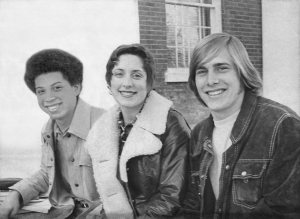When Ralph Eubanks arrived at the University of Mississippi as a student from his hometown of Mount Olive in 1974, he never could have imagined that the Confederate symbolism that defined Ole Miss would disappear.
“We saw (the Confederate flag, Colonel Reb and the statue) as things that were entrenched, that we just had to tolerate,” Eubanks said.

Eubanks. Photo by Katherine Butler.
After serving as Director of Publishing of the Library of Congress, Eubanks, who returned to campus in 2017 as a visiting professor of English and Southern studies, has seen the unthinkable happen in the years since he was an undergraduate.
The changes — including Colonel Reb being taken off the field in 2003, the state flag coming down in 2015 and the Associated Student Body Senate voting unanimously to relocate the Confederate statue on Tuesday night — are personal to Eubanks.
“My mother never liked coming here because she said, ‘I can’t look at the Lyceum without seeing blood running down the steps.’ I couldn’t say anything,” Eubanks said. “I think that what makes (Ole Miss) much easier to defend is seeing what the current students are doing. … This has become a space in which they feel empowered.”
In 1974, Ole Miss students could not openly discuss the implications of Confederate symbols on campus. Even today, Eubanks said, the statue is meant to keep black people silent and preserve a rigid color line.
“That marker was put there to say, ‘Go,’ to black citizens,” Eubanks said. “It is for white citizens to say, ‘This is ours,’ (and) to mark their territory. ‘This is not yours, and this can never be yours.’”
The Confederate statue was not the only symbol conveying this message during Eubanks’s time as a student. Even though Ole Miss was “one big memorial to the Lost Cause,” Eubanks refused to respond to that messaging. When campus celebrated “Dixie Week,” Eubanks defiantly attended.
“I used to show up to stuff like that with my big old afro just to say, ‘I’m here. You can’t exclude me,’” Eubanks said. “My doing that then was considered a somewhat radical act.”
In the 1970s, black students were fighting for a presence on campus. In a class of about 800, Eubanks was one of about 50 black students.
“What we were really pushing for was representation,” Eubanks said. “We were trying to get into the system. … If we were a part of it, we could change it.”
Steve Yarbrough, an author who teaches at Emerson College, attended Ole Miss at the same time as Eubanks. But because Yarbrough is white, the change in perception through the years he had was different.
Yarbrough grew up attending an all-white private school and learning that “the Confederacy was badly treated by the rest of the country” from his father, who was a member of the White Citizens’ Council.
At college, though, Yarbrough began to rethink his previous ignorance about Confederate symbols.
“I didn’t think as I should have about what it might have been like for Ralph (Eubanks) to walk past one of those statues,” Yarbrough said. “My own ideas about (Confederate symbols) began to change when I was finally around some African-American students in college.”

From left: Ralph Eubanks, Eileen Shull, Hardy R. Stone. Photo courtesy : University of Mississippi / Office of Public Relations
Now, as more and more students’ ideas about Confederate symbolism have changed, the university is being forced to reckon with its past once again. Though Eubanks maintains that Ole Miss can never separate completely from its Civil War history, he believes that the statue overshadows more important discussions.
“We have to embrace all of (our history’s) complexities and all the wounds that it brings up,” Eubanks said. “That statue is keeping us from having the right kind of conversations.”






